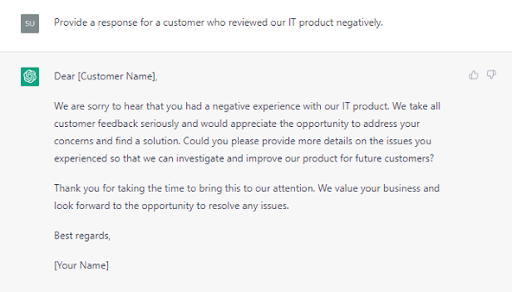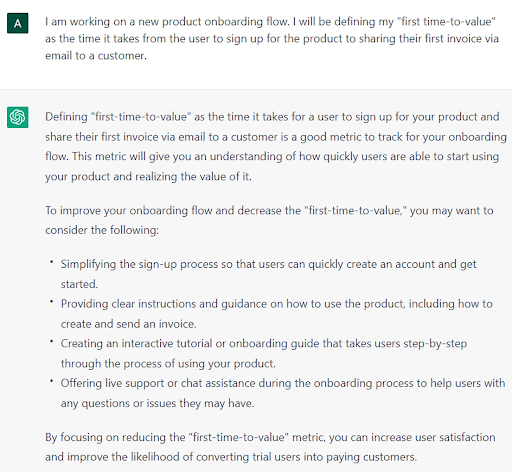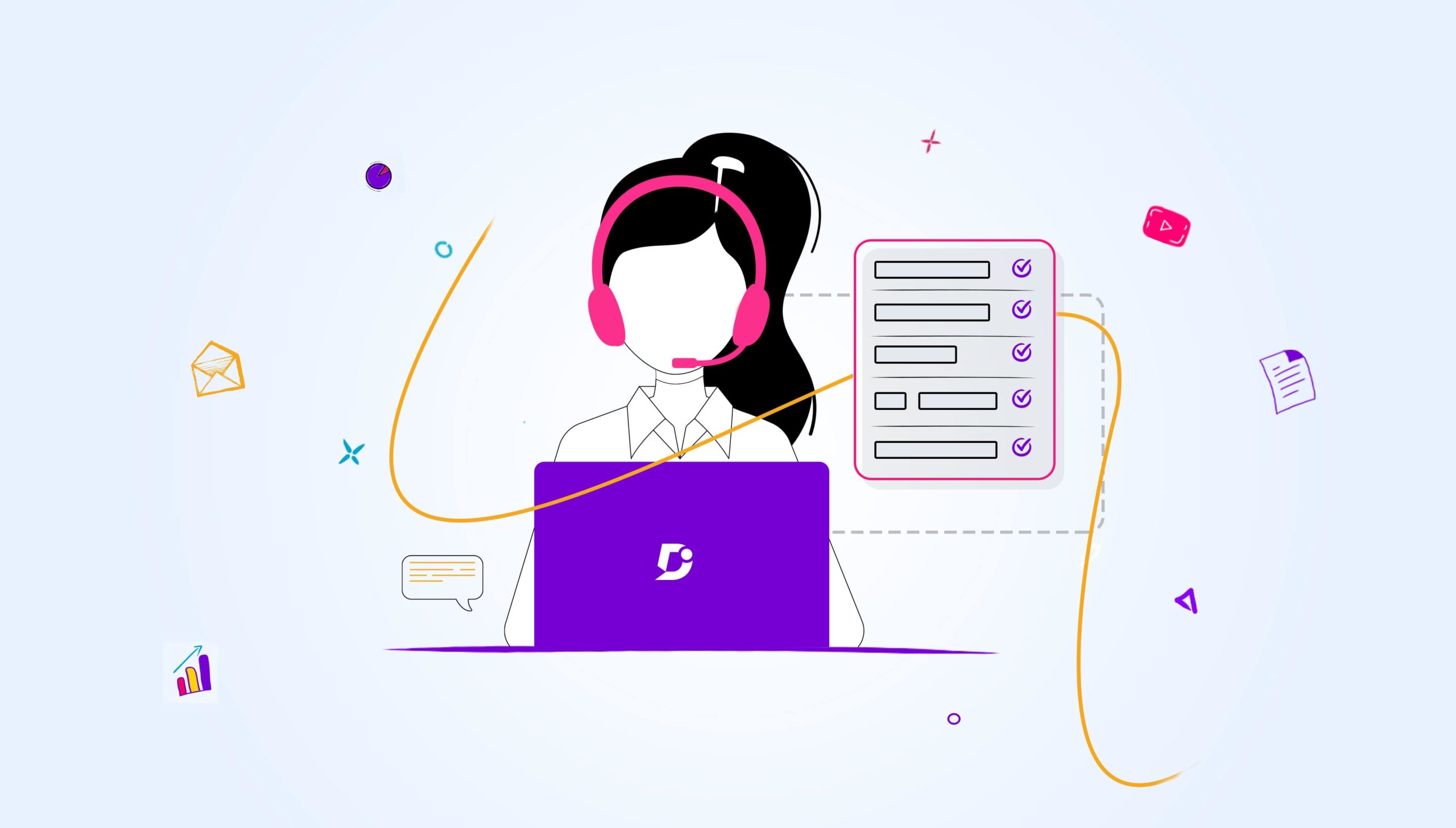Many customer service teams are profoundly interested in advancing technology to help customers. As AI solutions improve, so too are customer expectations rising for what customer service teams should be able to deliver. One such tool raising the bar is ChatGPT by OpenAI, which is a conversational AI chatbot.
Customer service teams are already using AI chatbots in their interactions with customers, but their uses are fairly limited. Chatbot responses to customer questions have been robotic and lacking in empathy, with more complex conversations needing a hand-off to agents.
ChatGPT is revolutionizing the role of Artificial Intelligence in customer service, with capabilities the likes of which have never been seen before, or only been imagined. Only having been released in November 2022, ChatGPT surpassed one million users within five days and that number is still growing.
If you don’t want to get left behind, seriously consider ChatGPT for your customer service team.
Role of ChatGPT in Customer Service
ChatGPT was not strictly built with customer service in mind, but its ability to generate human-like responses and creatively answer questions has made it of interest to customer service teams. For many typical customer inquiries, ChatGPT will be able to find a coherent answer – if the information is already available somewhere.
Like other AI technologies, ChatGPT can play a role in augmenting human service and being able to deflect minor or common queries. Since many customer queries are repetitive, ChatGPT can be trained to answer them and simulate the experience of interacting with a human.
For AI chatbots like ChatGPT to be successful, they must be in some ways smarter than the humans they seek to serve. It must be easier to start a conversation with ChatGPT than simply googling an answer to your question. Part of great customer service is understanding what customers mean, rather than simply focusing on what they say.
Top 8 Use Cases for ChatGPT/AI in Customer Service
Multilingual Support
ChatGPT is not just limited to the English language – it can provide multilingual support to customers around the globe, significantly expanding the reach of your business’s customer base. For ChatGPT, it doesn’t matter what language a customer converses in since it will be able to understand multiple languages.

Sentiment Analysis
ChatGPT can understand the emotion behind a customer’s query and respond appropriately with the right tone. Sentiment analysis makes customer support more effective by tailoring responses to the customer’s mood. It tries to read a customer’s state of mind more like a human to respond in kind.

Personalized Response to Complaints and Queries
If ChatGPT can be integrated with customer service systems and trained on specific customer data, it has the ability to supply personalized responses to customer complaints and queries. A personalized response means that it has been tailored to take into account a customer’s specific circumstances.

Customer Review Response
When customers post reviews about your business’s customer service online, ChatGPT could be trained to respond to those reviews appropriately so that reviews never go unanswered. Much like a human customer service agent would deal with reviews, ChatGPT can thank customers for their contributions or apologize for mistakes.

Helps in Customer Onboarding
ChatGPT could help customers during the onboarding phase by providing answers to common questions without requiring the intervention of a human agent. Providing such a level of automation in the onboarding process helps retain more customers and ensure product adoption, because ChatGPT is intervening before it is too late.

Engagement with Company Offers
ChatGPT can be used to recommend company offers to customers during support interactions so customers feel like they can get a better deal. ChatGPT can come up with ideas for when customers would be open to a cross-sell or an upsell, for example when they have reached the limitations of their plan.

Create Customer Emails
Your customer service agents could input customer inquiries into ChatGPT and use it to draft answers to customer emails. Instead of agents having to write everything out by hand, ChatGPT can generate responses which your agents can then customize for their own purposes.

Answering FAQs
You can use ChatGPT to answer FAQs from customers because if there is one thing ChatGPT is good at it is giving a straightforward answer to a simple question. In the future, we could even use ChatGPT to recommend particular knowledge base articles to customers to help them find the information they need.

Also Read: The Future of Knowledge Base in the Age of Generative AI
Benefits of ChatGPT/AI for Customer Service
24/7 Availability
Unlike your customer service team which must clock off and go home, ChatGPT is available 24/7 for your customers. This means that even if customers have a burning question during the middle of the night, they will be able to obtain an answer from ChatGPT. This also has huge implications for global customer bases who may be reaching out to customer service at any time depending on their time zone.
Automation
ChatGPT can be used to automate away the majority of routine inquiries through self-service, eliminating the need for manual processes. Customer service agents can be freed up to engage in tasks that require a human level of intelligence with more insight and creativity. This has consistently been one of the top applications of AI technologies.
Instant Response
Rather than having to wait around in long queues, customers can gain instant answers from ChatGPT which are certainly faster than those that could be obtained from a human agent. ChatGPT can then achieve faster resolution times through the application of AI technology that has the ability to help customers.
Reduce Cost to Company
Human workers are the biggest cost of any company, and utilizing the capabilities of ChatGPT will mean customer service teams need no longer expand to accommodate a growing customer base. There is no limit to the number of customers that ChatGPT can serve compared to the restrictions of time and effort for a human agent.
Prioritize Tickets Based on Level of Urgency
If customer tickets come into ChatGPT that are highly urgent, ChatGPT can prioritize them for attention by human agents. In this way, ChatGPT can help you deal with the tickets that matter most and make sure no issues fall through the cracks. Whilst it would take your agents time to manually categorize and prioritize tickets, ChatGPT will be able to do this automatically.
Increased Customer Satisfaction
No matter how their problems are resolved, customers will be more satisfied if they receive great customer service. ChatGPT seems more human-like than its predecessors, fuelling the interests of customer service teams who are interested in this technology. Nowadays customers don’t care whether it is a human or chatbot dealing with their issue as long as it is resolved, meaning that chatbots have huge potential to enhance your customer service strategy.
Consistency in Handling Similar Customer Tickets
One drawback of ChatGPT is that it may return different answers to the same questions, but as long as the question is phrased correctly ChatGPT should serve consistent answers. This offers a superior level of service to customers compared to the variation you might get from a team of agents who are all approaching problems in different ways.
Simulates Human Interaction
While ChatGPT’s interactions sound like a human, it can even go so far as remembering and referring back to earlier conversations and keeping the thread going with customers. The back and forth between ChatGPT and customer also seems very natural, with ChatGPT having the ability to present information in many different formats.
Schedule a demo with one of our experts to take a deeper dive into Document360
Book A Demo
Limitations of ChatGPT/AI in Customer Service
Before you get too excited about ChatGPT, there are some important limitations that you need to consider.
Limited Knowledge
If you ask ChatGPT a question that falls outside the scope of the data it has been trained on, it will fail to answer you. It will instead try to fill in the gaps in its knowledge by supplying conversation, when a better solution would be to escalate the matter to a human agent. ChatGPT only knows as much as the information that has been captured before, and is incapable of generating true insight.
Lacks Emotional Touch
At the end of the day, ChatGPT is a robot and although its conversational style is human-like, it still lacks the emotional touch. This absence of personal feeling may drive already frustrated and upset customers to become even more disillusioned with your brand, so you should always be careful when deploying chatbot technology.
Limited Text Input
ChatGPT only accepts input in text form with limited characters, making it less than suitable for some forms of customer service. If customers are vague or rambling with how they approach ChatGPT they are unlikely to obtain a sensible answer from the bot.
Cannot Perform Multiple Tasks Simultaneously
With ChatGPT, you are limited to performing a single task at a time. You can’t multitask with ChatGPT so users must simply ask one question and then wait for the answer. For example, ChatGPT couldn’t analyze a customer’s question and simultaneously ask a colleague for help, since it is limited to a back-and-forth interaction.
Not Yet Fully Developed
ChatGPT is still in the early stages, despite intense interest from customer service teams. Since the technology is in its infancy, this means it still has bugs that need to be worked out and might not yet be suitable to be employed in a professional context of customer service. While ChatGPT is more advanced than comparable chatbot technologies, it still has a way to go in order to be ready for the general public.
Answers are in Machine or Formal Tone
While ChatGPT certainly sounds human-like, many of its answers come across as overly formal or robotic which is not good for friendly customer service. ChatGPT still doesn’t quite grasp the subtleties and nuances of interpersonal interaction, and has a way to go before it can achieve the level of casualness that many customers require.
Future of ChatGPT/AI in Customer Service
In the future, ChatGPT will be able to integrate with customer service systems to make changes to orders and customer accounts. ChatGPT will not only be able to reply to customers but also be able to take action on their behalf.
At the moment, ChatGPT has the tendency to offer inaccurate responses when it does not know the correct answer to a question. The technology will develop to a point where ChatGPT will realize when it cannot help customers and escalate the matter to a human agent.
Hopefully, ChatGPT will progress to a stage where it can offer highly individualized answers to customers, no matter what their issue is. Of course, complex cases will always have to be escalated to the people on your team, but ChatGPT should be able to make basic changes such as account updates or amending bookings.
Also Read: How Technical Writers can Utilize ChatGPT?
Wrapping Up
ChatGPT is generating a lot of excitement among customer service teams but it is not quite ready to support your human agents yet. ChatGPT can be fun to play with because it is highly intelligent, having been trained on vast amounts of data, and yet the technology is still easily thrown by questions it does not know the answer to.
Being able to automate away mundane queries is of intense interest to customer service teams that want to scale, even despite a spike in tickets. If a machine can handle the majority of customer inquiries, customer service agents are free to focus on adding value instead of fighting fires.
There are exciting possibilities for customer service teams to be able to do more to help their customers while keeping the quality of service high. ChatGPT’s conversational style will feel convincing and familiar to customers who want the speed of a bot but don’t want to lose the human touch.
An intuitive knowledge base software to easily add your content and integrate it with any application. Give Document360 a try!
GET STARTED








